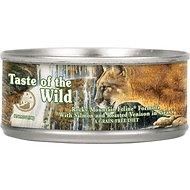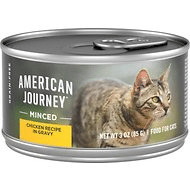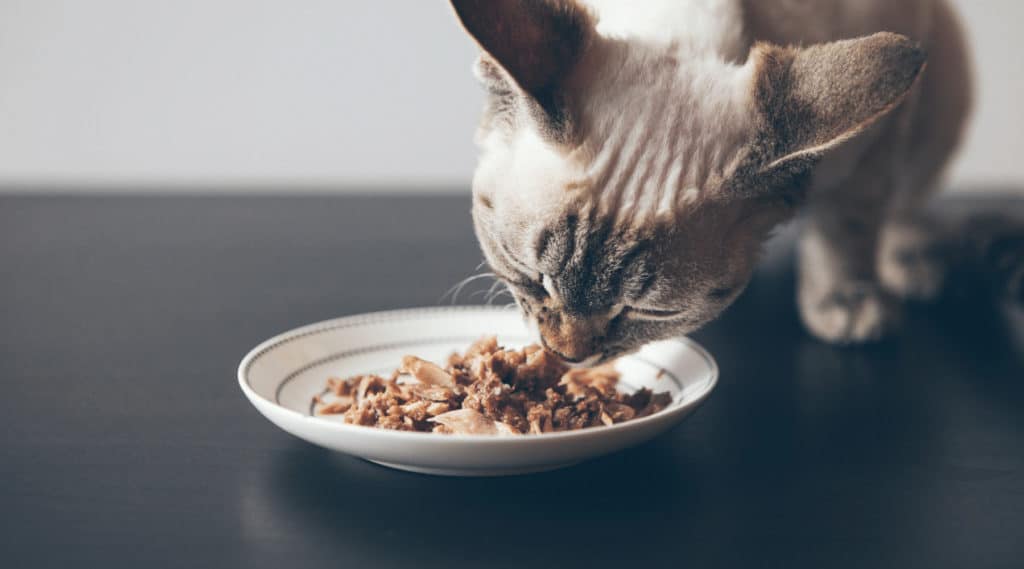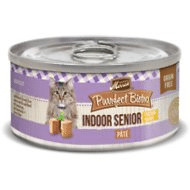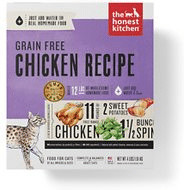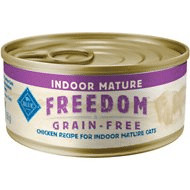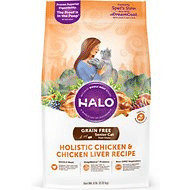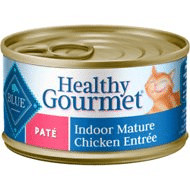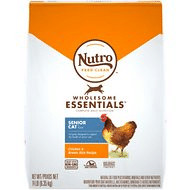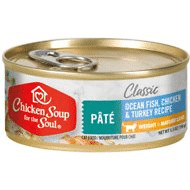Contents
- What is the Best Food for Older Cats with Bad Teeth?
- The Basics of Dental Health in Cats
- Is Wet Food or Dry Food Better for Older Cats?
- What to Look for in a Good Cat Food for Older Cats with Bad Teeth
- How Do We Make Our Recommendations?
- The 10 Best Cat Foods for Older Cats with Bad Teeth
- Small Ground Bird Human-Grade Fresh Cat Food
- Taste of the Wild Rocky Mountain Grain-Free Canned Cat Food
- American Journey Minced Chicken Recipe in Gravy Grain-Free Canned Cat Food
- Merrick Purrfect Bistro Indoor Senior Pate Grain-Free Canned Food
- The Honest Kitchen Dehydrated Cat Food
- Blue Buffalo Basics Limited Ingredient Indoor Mature Chicken Recipe Grain-Free Canned Cat Food
- 4 More Top-Rated Cat Foods for Older Cats with Bad Teeth
- Halo Holistic Chicken & Chicken Liver Recipe Grain-Free Senior Dry Cat Food
- Blue Buffalo Healthy Gourmet Pate Chicken Entrée Indoor Mature Canned Cat Food
- Nutro Wholesome Essentials Chicken & Brown Rice Recipe Senior Dry Cat Food
- Chicken Soup for the Soul Weight & Mature Care Ocean Fish, Chicken & Turkey Recipe Canned Food
- Frequently Asked Questions
Does the idea of brushing your cat’s teeth sound ridiculous to you? Or even dangerous? With all of those sharp teeth, trying to do something like brush your cat’s teeth could result in a bite. That is, of course, if your cat will even sit still long enough for you to try.
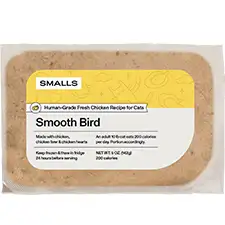
Smalls Human-Grade Ground Bird Fresh Cat Food
- Natural sources of taurine
- High in protein
As silly as it may sound to brush your cat’s teeth, oral hygiene is just as important for pets as it is for people. A majority of pets develop some degree of dental disease by the time they reach their third birthday and even minor dental issues can develop over time into serious health problems. Your cat relies on his strong and healthy teeth to eat well, so don’t take his dental health lightly!
In this article, we’ll explore in greater depth the basics of dental health in cats and explore the issues that tend to arise as your cat gets older. We’ll talk about whether wet food or dry food is best for senior cats and learn what to look for in a cat food for older cats with bad teeth. Finally, you’ll receive a list of our top picks for the best food for dental problems in older cats.
What is the Best Food for Older Cats with Bad Teeth?
- Small Ground Bird Human-Grade Fresh Cat Food
- Taste of the Wild Rocky Mountain Grain-Free
- American Journey Minced Chicken Recipe in Gravy d
- Merrick Purrfect Bistro Indoor Senior Pate Grain-Free
- The Honest Kitchen Dehydrated Cat Food
- Blue Buffalo Basics Limited Ingredient Indoor Mature
- Halo Holistic Chicken & Chicken Liver Recipe Grain-Free
- Blue Buffalo Healthy Gourmet Pate Chicken Entrée Indoor
- Nutro Wholesome Essentials Chicken & Brown Rice Recipe
- Chicken Soup for the Soul Weight & Mature Care Ocean Fish
The Basics of Dental Health in Cats
In regard to feline health, you may be familiar with some of the more common issues. Things like food allergies, fleas or mites, and skin and coat problems are fairly common. What’s even more common – and an issue you might not even think about – is dental disease. If you think your cat’s teeth are fine, you might be shocked to learn that almost 70% of cats aged 3 and older have signs of dental disease.
When it comes to diagnosing dental issues in cats, common symptoms include
- Bad breath
- Discolored teeth
- Visible tartar on teeth
- Difficulty eating
- Excessive drooling
- Pawing at the teeth/mouth
- Swollen gums
- Loose or missing teeth
- Redness or bleeding gums
- Weight loss
Most cats that develop dental issues don’t receive any dental care at home. Without even an annual dental health checkup, the condition of your cat’s teeth could be getting worse year after year. Because many cats live to be 15 years old (or older), dental issues in older cats are very common. Fifteen years of ignoring your cat’s dental health could leave him with serious dental health problems or no teeth at all.
Here are some simple tips to help you improve and maintain your cat’s dental health:
- Check your cat’s breath for a fishy odor (a sign of dental disease)
- Don’t skip your cat’s annual checkup with includes a dental check
- Start brushing your cat’s teeth as a kitten so he gets used to it
- Get your cat used to having his teeth cleaned by brushing a few teeth at a time
- Consider a bristled finger brush if your cat doesn’t like a toothbrush
- Stimulate your cat’s gums while brushing to help reduce inflammation
- Give your cat occasional dental treats to help remove plaque from his teeth
Now that you have a better understanding of your cat’s dental health, you may be wondering which food is best. In the next section, we’ll talk about the differences between wet food and dry food to determine which option is best for senior cats with bad teeth.
Is Wet Food or Dry Food Better for Older Cats?
The most common risk factor for dental disease in cats is lack of adequate teeth cleaning. If you care about your cat’s dental health, make an effort to brush his teeth at least a few times a week. Dental treats and chews can help a little bit, but there is no substitute for a good cleaning. If you absolutely can’t brush your cat’s teeth yourself, consider taking him in for an annual or semi-annual professional teeth cleaning to keep up with his oral hygiene.
On top of brushing your cat’s teeth, you may want to think again about what you’re feeding him. At this point, you may be wondering whether wet food or dry food is best for older cats, particularly cats who have already developed dental problems.
There are many arguments out there both for and against wet food for dental health in cats. On the one hand, wet food is easier to chew, a benefit for cats with bad teeth. Wet food is also more likely to get stuck between the teeth, however, which can exacerbate dental disease that already exists. The other argument is that dry food helps scrape the teeth clean, but that may not necessarily be the case.
According to an article published by Smalls, kibble doesn’t necessarily clean a pet’s teeth. In most cases, the kibbles shatter when they are pierced by the pet’s sharp teeth. Add to that the fact that many cats barely chew their food at all, and you’re left wondering whether Smalls might be right. The longer your cat spends chewing its food, the more it will help clean the teeth. This is why raw bones are so popular for pets – their texture makes them more difficult to chew but still soft enough for safety. Raw bones don’t splinter like cooked bones, so they are safe for pets.
In the end, it is your decision what you choose to feed your older cat. Take into account his dental health as well as his preferences when choosing the best cat food recipe.
What to Look for in a Good Cat Food for Older Cats with Bad Teeth
Cats tend to live fairly long lives, so you may not even notice when your cat makes the transition into seniority. In fact, cats spend about 40% of their lives as seniors, so it is particularly important to feed your cat a diet formulated for his unique nutritional needs. When looking for a good food for senior cats, you need to think not just about how easy the food will be to eat, but also the nutrition it delivers. Older cats have slightly different needs than adult cats and very different needs than kittens.
Here are some of the things we look for in a good cat food for senior cats:
- High-quality animal protein. Cats are obligate carnivores, so protein needs to be the foundation of any diet, regardless your cat’s age. A single source of protein is good for older cats because they often have sensitive stomachs, but the percentage of protein is just as important.
- Wholesome, natural ingredients. Digestibility is very important in a diet for older cats and natural whole food ingredients are much more digestible than fillers and by-products. Look for a diet made with real animal proteins, healthy animal-based fats, and digestible carbohydrates.
- Rich in moisture and flavor. Cats don’t tend to drink a lot of water anyway, but hydration is particularly important for senior cats. Recipes higher in moisture are easier to digest and if the moisture comes from flavorful ingredients like broth, it may boost your picky senior cat’s appetite as well. Plus, wet food is easier for cats with dental problems to chew.
- Reduced fat and calorie content. As your cat gets older, he is likely to slow down which means he won’t be burning as many calories. Good senior cat foods tend to be lower in fat and calories than the average adult kibble for this reason.
- Complete and balanced nutrition. No matter how old your cat gets, balanced nutrition will always be essential. Look for a recipe that contains fruits and veggies as natural sources of key nutrients with vitamin and mineral (ideally chelated) supplements for balance.
Now that you know what to look for in a good cat food for older cats with bad teeth, you’re ready to start shopping! If you’re still looking for a little more guidance, don’t worry – we’ve accumulated a list of recommendations for you. Before you read them, however, we suggest you take a look at how we make our recommendations so you can better understand the choice you’re making for your cat.
How Do We Make Our Recommendations?
As we’ve already mentioned, cats are obligate carnivores. But what does that mean? Think about this – dogs are scavenging carnivores which means that they prefer meat but can subsist on plant material for a limited time when necessary. As an obligate carnivore, your cat’s body is simply not designed to process plant foods efficiently and animal protein is a necessary component of the diet. This is the most important thing we look for when evaluating cat food recipes, but we also look for digestible sources of carbohydrate, healthy animal-based fats, and other nutritious ingredients.
Here are some of the requirements for a cat food to receive our recommendation:
- A source of high-quality animal protein as the first ingredient
- At least 30% crude protein for kittens and at least 26% for adults
- A minimum of 9% crude fat for kittens and adults
- A balance of omega-3 and omega-6 fatty acids, primarily from animal sources
- A rich blend of nutrients from natural sources and supplements, as needed
- Limited carbohydrate content from digestible sources (like whole grains and veggies)
- No low-quality fillers, by-products, or artificial additives (preservatives, dyes, or flavors)
All of these recommendations are made based on AAFCO food nutrient profiles which outline the minimum nutritional needs of cats in various life stages (kitten or adult). In order to determine whether a cat food meets these requirements, just look for an AAFCO statement of nutritional adequacy on the package. It should look something like this: [X Product] is formulated to meet the nutritional levels established by the AAFCO Cat Food Nutrient Profiles for all life stages.
The 10 Best Cat Foods for Older Cats with Bad Teeth
The best cat food for dental problems may come in many forms, depending on your cat’s individual preferences and nutritional needs. For some senior cats, dry food is perfectly fine while others require a softer diet. No matter what you choose, be sure it is a high-quality recipe that will provide for your cat’s basic nutritional needs. Here are our top picks for the best senior cat food in different categories:
| Our 2024 Picks: Best Foods for Older Cats with Dental Issues | |||
Small Ground Bird Human-Grade Fresh Cat Food
|
CHECK PRICE | ||
Taste Of The Wild Rocky Mountain Grain-Free
|
CHECK PRICE | ||
American Journey Minced Chicken Recipe In Gravy
|
CHECK PRICE | ||
Merrick Purrfect Bistro Indoor Senior Pate
|
CHECK PRICE | ||
The Honest Kitchen Dehydrated Cat Food
|
CHECK PRICE | ||
Blue Buffalo Basics Limited Ingredient Indoor Mature
|
CHECK PRICE | ||
Halo Holistic Chicken & Chicken Liver Recipe Grain-Free
|
CHECK PRICE | ||
Wellness Natural Hairball Control Chicken Meal
|
CHECK PRICE | ||
Nutro Wholesome Essentials Chicken & Brown Rice Recipe
|
CHECK PRICE | ||
Chicken Soup For The Soul Weight & Mature Care Ocean Fish
|
CHECK PRICE | ||
Small Ground Bird Human-Grade Fresh Cat Food
Overall Best Cat Food for Older Cats with Bad Teeth: Referring back to the information above, Smalls explains that dry kibble isn’t necessarily the best for a pet’s teeth. In fact, they suggest that it doesn’t do much at all to help keep the teeth clean. There are plenty of pet experts who disagree, but if you’re of the mind that dry food isn’t the best option for your senior cat, go with something nutritious and high-quality like Smalls. Compared to traditional canned foods that are cooked at high temperatures and artificially preserved, Smalls is freshly prepared and sent to your door in pre-portioned packages that are easy to feed. They use only the highest quality natural ingredients in their recipes to ensure complete and balanced nutrition that is highly digestible and good for your cat. Choose from two protein options and rest assured that your senior cat is getting the nutrition he needs to live out the rest of his life in optimal health.
- Pros: Fresh food delivered to your door, high-quality natural ingredients, highly digestible, rich in moisture and protein, complete and balanced nutrition, choose from two proteins
- Cons: Significantly more expensive than kibble, only two recipes to choose from
Taste of the Wild Rocky Mountain Grain-Free Canned Cat Food
Most Popular Cat Food for Older Cats with Bad Teeth: There are dozens, maybe even hundreds, of different cat food brands out there which can make it difficult to choose a single recipe. If you’re not sure where to start your search, consider a trusted brand like Taste of the Wild. We particularly recommend this Rocky Mountain Grain-Free Canned Cat Food recipe for aging cats with teeth issues because it is highly nutritious, easy to digest, and easy to chew. This formula features fresh salmon as the main ingredient, followed by fish broth and chicken broth as flavorful sources of moisture. You’ll also find chicken liver, fresh chicken, smoked salmon, and roasted venison as supplemental sources of premium animal protein. All in all, this recipe is highly digestible, complete and balanced in terms of nutrition, and loaded with real meat flavor that is sure to stimulate your older cat’s appetite while being easy to chew.
- Pros: Fresh salmon main ingredient, several premium animal proteins, rich in natural flavor and moisture, complete and balanced nutrition, highly digestible, chelated minerals
- Cons: Not a single-source protein recipe, some senior cats may be sensitive to chicken
American Journey Minced Chicken Recipe in Gravy Grain-Free Canned Cat Food
Most Affordable Cat Food for Older Cats with Bad Teeth: The previous recipe is a great option if you’re looking for the best of the best for your cat. Unfortunately, the best cat foods can be very expensive but that doesn’t mean you need to pay a fortune for something good. This American Journey wet cat food is very affordable and delivers a high-quality dose of complete and balanced nutrition for your senior cat. This recipe features fresh chicken as the main ingredient and s single source of animal protein. It is supplemented by chicken liver, a rich source of nutrients, with chicken broth and turkey broth to provide both flavor and moisture. This recipe is completely grain-free and easy to digest, plus it is supplemented with vitamins and chelated minerals to ensure complete and balanced nutrition.
- Pros: Affordable price, single-source animal protein, rich in moisture and flavor, easy to digest and chew, rich blend of omega fatty acids, complete and balanced nutrition, chelated minerals
- Cons: Not formulated specifically for senior cats
Merrick Purrfect Bistro Indoor Senior Pate Grain-Free Canned Food
Best Wet Cat Food for Older Cats: When it comes to choosing the best cat food for older cats, many pet parents prefer wet food. If you’re looking for a recipe that is specifically formulated for older cats and made with wholesome, natural ingredients, try this Merrick Purrfect Bistro Indoor Senior Pate Grain-Free Canned Food. This formula features fresh salmon as the main ingredient with chicken liver as a nutritious source of supplemental protein. It is a grain-free recipe, made with digestible carbohydrates like peas, and it provides a rich blend of omega-3 and omega-6 fatty acids. Overall, this recipe provides 8% protein and 3% fat with 2.5% moisture which, converted to a dry matter calculation, is 42% protein, 16% fat, and about 13% fiber.
- Pros: Formulated for senior cats, rich in premium animal protein, single source protein, digestible grain-free carbohydrates, limited number of ingredients, complete and balanced, rich in moisture
- Cons: Contains some plant protein (pea protein), may be too high in fiber for some cats
The Honest Kitchen Dehydrated Cat Food
Best Soft Dry Cat Food for Cats with Bad Teeth: One of the major benefits of dry pet food is that it has a longer shelf-life. If you like the idea of being able to store your cat’s food at room temperature, but you aren’t sure regular kibble will be easy enough for your cat to eat, consider a soft dry cat food for cats with bad teeth. The Honest Kitchen offers a selection of dehydrated cat foods which are technically dry foods because they have had their moisture removed, making them stable and storable at room temperature. What makes these foods a good choice for cats with bad teeth is the fact that you can rehydrate the food with water or broth to make it softer and more palatable. Choose from two grain-free options featuring premium proteins like fresh chicken and turkey with other natural ingredients.
- Pros: High-quality animal protein, dehydrated not cooked to preserve nutrition, wholesome natural ingredients, digestible grain-free recipe, fruits and vegetables as natural sources for key nutrients
- Cons: Significantly more expensive than kibble, some cats dislike the rehydrated texture
Blue Buffalo Basics Limited Ingredient Indoor Mature Chicken Recipe Grain-Free Canned Cat Food
Best Cat Food for Senior Cats with Sensitive Stomachs: Many cats develop food allergies and sensitivities as they get older which limits your choices when shopping for cat food. If you’re looking for a recipe specifically formulated for senior cats that won’t upset your cat’s sensitive stomach, a limited ingredient diet might be best. This Blue Buffalo Basics Limited Ingredient Indoor Mature Chicken Recipe Grain-Free Canned Cat Food is a great choice because it is highly digestible, rich in moisture, and contains a short list of main ingredients to limit the potential for negative reactions. As a wet food formula, this recipe is easier for cats with bad teeth to chew and it contains higher levels of protein than the average dry food. It is a rich source of omega-3 and omega-6 fatty acids to support your aging cat’s skin and coat, plus it is rich in dietary fiber to ensure healthy digestion. Overall, it provides 7% protein and 4% fat with 2.5% fiber which, converted to a dry matter calculation equates to nearly 32% protein and 18% fat with 11% fiber.
- Pros: Single source of animal protein, limited number of ingredients, digestible grain-free recipe, fresh fruits and vegetables, formulated for senior cats, highly digestible, rich in natural nutrients
- Cons: Wet food can get stuck between teeth, may be too high in fiber for some cats
4 More Top-Rated Cat Foods for Older Cats with Bad Teeth
If the 6 options for the best senior cat food above don’t seem like quite the right fit, don’t worry! There are plenty of other options out there. Whether you’re looking for a cat food for dental issues or the best cat food for older cats with no teeth at all, we’ve got some additional recommendations for you.
Here are 5 more options for the best wet food and kibble for cats with bad teeth:
Halo Holistic Chicken & Chicken Liver Recipe Grain-Free Senior Dry Cat Food
Another option we like for the best dry cat food for senior cats with bad teeth is this Halo Holistic Chicken & Chicken Liver Recipe Grain-Free Senior Dry Cat Food. This holistic recipe is made with only the highest quality natural ingredients with no artificial additives. It features real, whole chicken as the main ingredient and a single source of premium animal protein. Supplemental protein comes in the form of eggs and soy protein isolate, both of which should be digestible for senior cats. This recipe also contains dried fruits and vegetables to provide a boost of natural nutrition to balance out the vitamin and chelated mineral supplements.
Blue Buffalo Healthy Gourmet Pate Chicken Entrée Indoor Mature Canned Cat Food
If you prefer canned food for your senior cat, we recommend this Blue Buffalo Healthy Gourmet recipe featuring protein-rich chicken as the first ingredient. This recipe is packed with protein and loaded with garden-grown vegetables, fruits, and whole-grain carbohydrates to ensure both high digestibility and balanced nutrition. Formulated specifically for senior cats, this food is rich in flavorful moisture from real broth, designed to optimize your cat’s digestion and support urinary health. It is proudly made in the USA with no by-products, fillers, or artificial additives so it will be gentle on your senior cat’s stomach.
Nutro Wholesome Essentials Chicken & Brown Rice Recipe Senior Dry Cat Food
As long as your cat doesn’t have a sensitivity or allergy to grains, whole grains provide a nutritious source of carbohydrate energy, essential nutrients, and dietary fiber. This Nutro Wholesome Essentials Chicken & Brown Rice Recipe Senior Dry Cat Food is formulated for senior cats and features fresh chicken and chicken meal as the first two ingredients. For carbohydrates, it includes whole brown rice and whole grain oatmeal. This recipe is rich in omega-3 and omega-6 fatty acids to support your cat’s skin and coat health, plus it is supplemented with chelated minerals and vitamins to ensure complete and balanced nutrition. Overall, it provides 36% protein and 17% fat with just 386 calories per cup.
Chicken Soup for the Soul Weight & Mature Care Ocean Fish, Chicken & Turkey Recipe Canned Food
As they get older, many cats start to slow down which means that they are burning fewer calories. Burning fewer calories means an increased risk for weight gain which is why we like this Chicken Soup for the Soul Weight & Mature Care recipe. Not only is it formulated for senior cats and loaded with flavorful moisture and animal protein, but it contains a lower concentration of calories to help your cat maintain a healthy bodyweight. It contains ocean fish as the primary source of protein with supplemental protein from chicken, chicken liver, salmon, turkey, and duck. Overall, it is highly digestible and provides complete and balanced nutrition for your senior cat’s health and wellness.
Frequently Asked Questions
- What are the signs of dental problems in cats? – The early signs of dental problems in cats are easy to miss because you probably don’t spend a lot of time looking at your cat’s teeth. In the beginning, dental issues may manifest simply as bad breath or tooth discoloration (due to the accumulation of plaque and tartar). Over time, these symptoms may progress into difficulty eating, drooling, pawing at the mouth, and swollen or bleeding gums. If you still neglect to get your cat the help he needs, he could end up losing weight from not being able to eat or could lose some of his teeth.
- Do older cats lose their teeth? – Dental disease is one of the most common afflictions in older cats. Early signs of dental disease in pets include gum inflammation and difficulty chewing, but those problems can progress to include tooth loss. Generally speaking, tooth loss is not normal for cats – even older cats. It is most frequently a sign of dental disease, so it isn’t something you should ignore. It happens when plaque builds up along the gum line, separating the teeth from the gums. This causes the tooth to loosen and eventually fall out.
- Is dry food or wet food better for older cats? – When it comes to choosing the best cat food for older cats, you may be wondering if there’s a difference between wet food and dry food. Generally speaking, veterinarians tend to recommend dry food over wet food for dental issues. Kibble for cats with bad teeth helps scrape away the plaque and tartar that builds up on the surface of the teeth and causes dental issues. Wet food for cats, on the other hand, can get stuck between the teeth and create an environment where bacteria can reproduce and cause gum disease. If your cat already has dental disease and has difficulty chewing, however, you may want to consider canned food anyway. The higher moisture content will also help keep your senior cat hydrated. Just be sure to brush your cat’s teeth as often as you can or have them professionally cleaned to prevent existing dental problems from getting worse.
- What age is a senior cat? – The first year of a kitten’s life flies by and they grow very quickly. Once your cat reaches his adult size, you might still think of him as a kitten at heart but a larger version of his younger self. Over the next few years, your cat’s behavior and personality may change, but he doesn’t grow much which makes it easy to miss his transition into seniority. Most vets consider a cat to be a senior sometime between 7 and 10 years of age. Given the fact that many cats achieve the ripe old age of 15 or more, your cat might spend 40% or more of his life as a senior.
- How can I make my cat’s food easier to eat? – If you have a senior cat with bad teeth but you don’t want to completely change your cat’s diet, you have other options. One option is to check with the brand of pet food you currently use to see if the dry food recipe comes in a canned food version. If not, you can always soften your cat’s dry food to make it easier to eat. If you’re wondering how to make dry cat food soft, you can simply add some warm water or chicken broth. Broth has the added benefit of making the food more flavorful which can help with senior cats who have a low appetite.
Though the idea of brushing your cat’s teeth may sound silly, it’s something you need to do if you care about your cat’s dental health. It’s best to start early, when your cat is a kitten, so he gets used to having his teeth touched. If you don’t fell like you can do it on your own, you should at least take your cat in for an annual professional cleaning.
On top of maintaining your cat’s dental health, you may also want to reconsider his diet when he becomes a senior – especially if he already has bad teeth. Take what you’ve learned here to determine what type of diet is best for your older cat then check out our recommendations above. Good luck!

